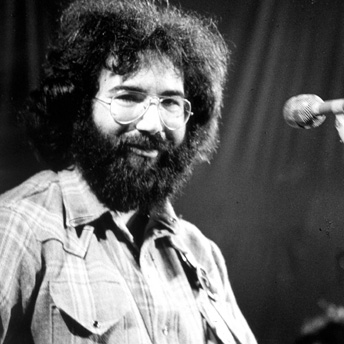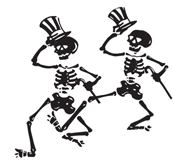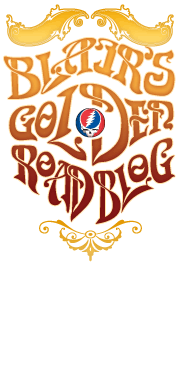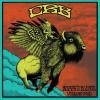“It Was All About Jerry.” If you’ve prowled Deadnet Central or other Grateful Dead message boards/sites through the years, chances are you’ve encountered “IWAAJ.” During what has become known in Dead Head circles as “The Days Between” (Garcia’s August 1st birthday through the day of his death, August 9th), I seem to see that abbreviation pop up in discussions even more, as folks weigh in and ponder Jerry’s passing and his impact, etc. But year-round, fans drop “IWAAJ” into online conversations in a variety of situations, perhaps most often as final punctuation in discussions about the relative merits of post-Garcia bands—as if that abbreviation, in and of itself, explains why RatDog or Furthur or any other group doesn’t possess that fully magical Grateful Dead X-factor; i.e. because Jerry is not part of it.
Well, duh! There’s no question that Garcia was the dominant creative force in the Grateful Dead. As an improvising guitarist without peer, passionate singer, chief songwriter, de facto spokesman for the group and possessor of an incredible mind and wit, Jerry left shoes impossible to fill. He is the major reason I spent 25 years and untold treasure going to see him at every opportunity, and why I have scribbled more than a million words (literally) about his exploits. I echo the sentiment of the bumper sticker I see occasionally: “I MISS JERRY EVERY DAY.”

But I don’t believe IWAAJ. One song into my first Grateful Dead show back in 1970, it was abundantly clear that there was a very special chemistry going on within the band and that each player was an integral and original part of the group’s overall sound. I had never heard another bass player like Phil Lesh, nor a so-called “rhythm guitarist” like Bob Weir. What the drummers were doing behind them was unlike the standard rock rhythms most bands trotted out. It was deeper and more complex. As I saw the band more often (13 times in those first two years), my appreciation of the uniqueness of each of the players and his contributions to the overall gestalt grew exponentially. And while that was happening, I was also learning that the Grateful Dead’s following was an audience unlike any other in music and that the atmosphere the band and crowd created together was its own wonderful thing. As the years went by, the specialness of the Dead audience (compared with other bands’ fans) and its bond with the band became even more apparent.
One reason Dead Heads are so obsessed about sound is because it was not AAJ. I clearly recall griping after some shows (especially at Winterland) that the band played great but I couldn’t really hear Phil as well as I’d like, or noting that Healy had Weir turned down way too low at many shows in the early ’80s. (Alas, the tapes confirm that assessment.) Sit on the extreme right or left of a hall during the later Healy era and you risked either being deafened by Brent or losing him for the most part. I always wanted to hear every instrument clearly and balanced, not just Jerry, and I certainly wasn’t alone in that sentiment.
When other players in the band had “off” nights, a spectacular night by Jerry helped but usually could not completely elevate a show to true greatness — all parts had to be in sync and moving smoothly for that to happen. Conversely, having everyone in the band playing really well except Jerry — as happened so often during the more disturbing portions of 1994 and 1995 — didn’t really do it, either. But I give the guys major points for heroically trying not to let his diminished capacity drag the music completely down. At a lot of those shows, it was AAEE — “All About Everyone Else.”
So, now we’re 16 years into the post-Garcia era, and there are still many folks who have no interest in hearing the ex-Dead members playing together, or they’ve checked it out and been disappointed (by its lack of Jerry-ness!). My feeling, though, is that so much of the Grateful Dead’s essence and Garcia’s spirit is ingrained in each of the surviving players, and within the songs themselves, that it isn’t at all hard for me to accept those players in new combinations reinterpreting this music I love, sometimes in radical ways. In the early days after Jerry died, it was the original Missing Man Formation lineup of Vince Welnick, Steve Kimock, Bobby Vega and Prairie Prince that first showed me I could feel that Grateful Dead spark again—that it didn’t take Jerry being there to get me off. So I’ve always tried to be open to whatever new lineups of players have come down the pike investigating and exploring the Dead’s musically egalitarian methodology (everyone is important!) and seemingly boundless repertoire. (It’s too bad it took Jerry’s death for us to hear everything from “The Eleven” to “Viola Lee Blues” to “The Golden Road” to “Mountains of the Moon” splendidly reinvented for modern times.)
All of the guys in the band are still playing fantastically well and seem to be dedicated to constantly reinvigorating the Dead canon. I’ve left shows by The Other Ones, The Dead, the Mickey Hart Band, Phil Lesh & Friends, RatDog, Furthur and other Dead-connected groups positively glowing, and that’s all the proof I need to believe that great as he was, and as much as I loved him, it was not AAJ — for me. And the crowds by and large remain a source of joy and inspiration, as well.
God, I miss Garcia! But I’m so happy that those he left behind didn’t just fold up the tent, close shop—whatever the appropriate metaphor is—and leave their shared history behind. The evolution continues, without Jerry, and it’s still putting smiles on faces and offering, to quote a recent Phil-Hunter tune, an invitation to the dance.
“Uncle John’s Band” asked, “Will you come with me? Won’t you come with me?” Yup, I will! Wherever it goes.
How ’bout you?





